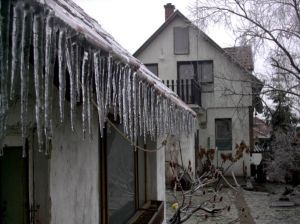
With Old Man Winter on the way, there’s quite a few things that you need to prepare for as a homeowner. You’ll need to make sure that your heating system is working properly. You’ll have to guard against frozen pipes by wrapping them appropriately and/or shutting off water flow. And you’ll have to be diligent in the battle against snow and ice accumulation on your sidewalks and driveways.
But you shouldn’t neglect one of the most potentially-damaging problems that can befall your home: ice dams. Ignoring or neglecting to plan for the possibility of ice dams can leave you having to deal with thousands of dollars in damages to your home’s interior.
How do Ice Dams Form?
Ice dams require a complex set of conditions in order to form on a home. First and foremost, significant snowpack must be present on a roof. Secondly, the outside air temperature must be below freezing. Third (and most importantly), the surface temperature on different portions of your roof must be different; more specifically, higher portions must be above 32 degrees, while parts closer to the roofline must be below 32 degrees.
When these conditions are in place, the snow on the parts of the roof that are above freezing starts to melt and flow down toward the roof’s edge. Normally, it would flow into the gutters and out through the downspouts; but once it hits the below-freezing roof areas, it freezes again into a sheet of ice known as an ice dam. As the ice dame grows, the melted water tries to seek the path of least resistance since it cannot reach the gutters. Instead, the water starts to seep through walls, ceilings, and the roof itself. In addition, the ice dam formation serves to expand and contract the ice, which can cause damage to soffits, gutters, siding, and roofs. Water then also finds these areas to invade as well.
How Ice Dams Are Harmful
Not surprisingly, unchecked water flow can create a significant amount of damage. Some of the most common manifestations of this damage include:
- water damage in ceilings, flooring, and walls
- mold and mildew in walls and ceilings
- soaked and ruined insulation in attics and walls
- rotted soffits and fascia boards
- buckled, bent, or separated gutters
- eroded landscaping
- flooded basements
- compromised foundations
How You Can Prevent Ice Dams
There are several steps that homeowners can take to minimize the impact of ice dams. The most low-tech measure is to remove the snow from a home’s roof using either a roof rake or a steamer system. If the entire roof is too large to make this project feasible, keeping the lowest 10 feet of roof snow-free may be sufficient to prevent the formation of ice dams.
Also, it’s vital that the home be as “leakproof” as possible. This means making sure that attics and ceilings are properly insulated so that no warm air can flow from the heated interior up to the cold roof, which can lead to the aforementioned temperature variations on the roof surface itself.
The Advantage of Heated Gutters
Another way to prevent damage caused by ice dams is by using heated gutters. Since most ice dams rely on solid ice frozen in gutters as a foundation, eliminating this ice base can substantially reduce the potential harm of ice dams. Heated gutters consist of a metal coil that is automatically heated via electricity when the ambient temperature drops below a predetermined threshold. The heat continuously melts any snow or ice, thereby allowing the runoff water to flow through the gutters as intended.
Moonworks is a respected supplier or heated gutters to New England homeowners. In addition, Moonworks can also aid residents with insulation services, gutter guards, and even home energy audits that can pinpoint areas where energy is being wasted. So contact Moonworks today at 1-800-975-6666 (or fill out the form to the right) to get more information on how to prepare your home against the scourge of ice dams this winter season.
